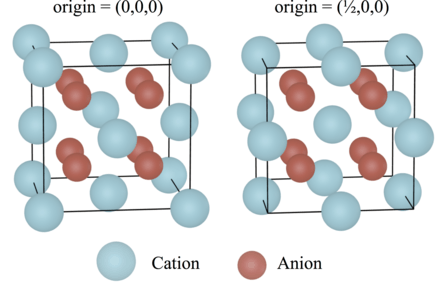Anti-structure
In crystallography, an anti-structure is obtained from a salt structure by exchanging anion and cation positions.

Unit cell of CaF2, known as fluorite structure, from two equivalent perspectives.[1]
In the antifluorite structure, the blue positions are taken by the anion, the red positions by the cation.
For instance, calcium fluoride, CaF2, crystallizes in a cubic motif called the fluorite structure. The same crystal structure is found in numerous ionic compounds with formula AB2, such as ceria (CeO2), zirconia (cubic ZrO2), uranium dioxide (UO2). In the corresponding anti-structure, called the antifluorite structure, anions and cations are swapped, such as beryllium carbide (Be2C) or lithium oxide (Li2O), potassium sulfate (K2SO4).
Other anti-structures include:[2]
- anti-SnO2: Ti2N
- anti-PbCl2: Co2P
- anti-CdCl2: Co2N
- anti-SdI2: Cs2O
- anti-NbS2: Hf2S
- anti-ReO3: Cu3N
- anti-LaF3:[3] Cu3P, Cu3As
References
- Burr, P. A.; Cooper, M. W. D. (2017-09-15). "Importance of elastic finite-size effects: Neutral defects in ionic compounds". Physical Review B. 96 (9): 094107. arXiv:1709.02037. doi:10.1103/PhysRevB.96.094107.
- Peter Paetzold: Chemie. Eine Einführung. de Gruyter, Berlin 2009
- Mansmann, M. (1965). "Über Verbindungen vom Anti-LaF3-Strukturtyp". Zeitschrift für Kristallographie - Crystalline Materials. 122 (1–6): 399–406. ISSN 2194-4946.
This article is issued from Wikipedia. The text is licensed under Creative Commons - Attribution - Sharealike. Additional terms may apply for the media files.